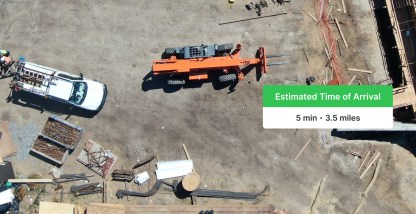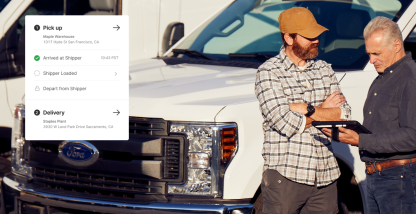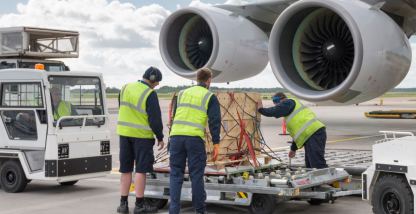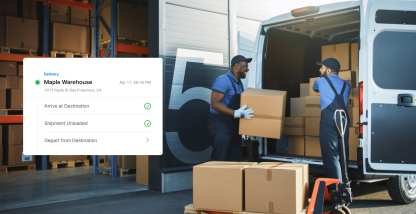Real-time visibility into your fleet’s operations and vehicle location is important for fleet managers to make timely decisions.
GPS tracking can help fleet managers locate their vehicles in real time. However, when you use geofencing in your fleet management, you can get even more data and insights, and strategic geofencing alerts can also automate and simplify overall management.
With geofencing alerts, fleet managers can learn if drivers are running late, prevent vehicle theft or misuse, improve efficiency at shippers and receivers, and keep customers updated regarding delivery schedules.
In this post, we’ll discuss a variety of ways to use geofencing in fleet management to increase efficiency and productivity.
What is geofencing?
A geofence is a virtual parameter in a real-world geographic area. Whenever a driver enters or exits that geofenced area, fleet managers can receive a notification.
These virtual boundaries or zones can be as narrow as a single-lane street, as vast as a whole country, or as outstretched as a highway.
Your pinpointed placement is known as geolocation and your borders around specific tracking points as geofences.
In geofencing, your software program uses Wi-Fi, cellular data, a global positioning system (GPS), or radio frequency identification (RFID) to trigger pre-programmed responses such as corresponding alerts.
Configuring locations with these triggers entails setting up “if this, then that” commands. For example, if Driver A enters this area, then send me an email alert.
Besides updates, you also get a broad perspective on your fleet’s real-time whereabouts and related activities within your designated zone.
GPS tracking and geofencing are used in numerous industries as part of their fleet management. For example:
- Delivery warehouses
- Shoppers receiving “today-only” sales announcements when passing by nearby retail shops they’ve subscribed to
- For moving companies to bill higher when customers drive vehicles outside predetermined places
- Construction areas, preventing vehicle theft, and equipment management
- For fleets to track vehicle idling and productivity at job sites and equipment storage.
8 ways geofencing in fleet management improves productivity
Fleet management companies are among the primary industries benefiting from geofencing systems.
How geofencing can be used in fleet management to improve fleet productivity:
1. Reduce administrative burden and increase efficiency.
Supervising fleets entails numerous time-demanding tasks, such as check-in phone calls, sending package ETA alerts to customers, and monitoring hours of service (HOS) for CMV drivers.
Geofencing can help you minimize administrative burden and increase the efficiency of day-to-day operations.
For instance, rather than calling (and distracting) your drivers to ask about their ETAs, set geo-boundaries around their loading spots, rest areas, destination, etc., and receive automated reports.
This minimizes the administrative burden of manually monitoring vehicles, eliminates the need for micromanagement and multiple phone calls, and ensures your drivers are on track.
Because of reduced administrative burden and increased efficiency, fleet managers may have more time for other business-critical tasks.
2. Simplify time and payroll management.
If you pay your drivers on an hourly basis, geofencing can help you track their working periods automatically.
You can create virtual time stamps and cards, integrated with geofences. When your staff passes through your digital, geofenced perimeters, your fleet management software can start recording the working hours.
This gives you accurate logs of when drivers appeared on their job sites and for how long they worked.
Once it’s time for payroll processing, your admin and finance team can calculate payroll with more accuracy, without having to deal with a lot of paperwork and manual record checking.
3. Plan smarter and improve asset deployment.
Geofencing in fleet management relies on GPS tracking, so the software can update you in real time and help you enhance your operational planning and scheduling.
With valuable geofencing and GPS data, you can see where your vehicles are, estimate their ETAs, adjust your proposed trips, and keep your shipping and other activities right on time.
4. Increase security and theft prevention.
Geofencing helps you enhance your fleet asset tracking and security because you receive alerts when your vehicles go beyond the approved routes and virtual boundaries.
If your vehicles are not where they should be, you will get a real-time geofenced alert. Then you can check into the incident to see whether this was authorized or not, if there was a valid reason for the deviation, or if your assets were stolen.
Real-time geofenced alerts can enable you to take timely action.
5. Improve performance, utilization, and efficiency monitoring.
Fleet managers can use geofencing in fleet management to supervise the performance of their fleet vehicles and how it ties into the bottom line of your company.
GPS tracking and geofencing can provide valuable data and insights: the average time duration it takes vehicles to get from point A to point B, turnaround times (TAT), operational cost, fuel expenditures, etc.
You can even see which vehicles in your fleet operate more than the rest, which routes are most expensive or efficient, and other utilization data within your set geofence.
A classic use case is when you have several shipments to drop during the day. The faster your trucks can reach and set off to their next stops, the more fuel, time, and other resources you can save.
This makes things more efficient not only for you but also for your customers. Once your trucks pass by the geofences, your clients can receive alerts ahead of time about their packages nearly arriving.
They can then prepare themselves to receive the orders, reducing confusion and delays, and your drivers can immediately move to their next destination.
Additionally, if you notice your drivers going through longer routes they think are faster, you can show them otherwise and guide them to the best courses.
In this way, you can determine ways to optimize your processes.
6. Make smarter business decisions.
Consequently, these performance data give you in-depth and big-picture perspectives for making sound, informed, data-driven business decisions.
You can better understand your ROI for particular assets and fleet activities, compare performances on specific seasons in a year, etc.
This lets you strategize, set up policies, and create better annual budgets that can maximize your investments and minimize operating expenditures.
7. Improve compliance and fleet safety.
Geofencing can also help you improve compliance and fleet safety. One way is by initiating your traffic restriction management.
In many urban places, authorities limit using large commercial vehicles to specific hours or completely forbid particular vehicle types from operating on certain roads.
Geofences or boundaries installed around these restricted areas can notify you when your trucks are about to enter off-limits areas. In addition, drivers can also avoid any other dangerous areas determined by you.
You can receive timely alerts and re-route your drivers. This can help you improve compliance and the safety of your fleet.
8. Improve customer satisfaction.
Finally, when you use geofencing in fleet management, you can improve customer satisfaction by providing them timely alerts and keeping them in the loop with up-to-date ETAs.
You can use GPS tracking and geofences to identify vehicles close to your clients’ locations for faster deliveries. Moreover, you can also set up geofence alerts — checkpoints for drivers — that keep you updated on how far your drivers are to the delivery point.
Relay that information to your customers for a better customer experience and higher customer satisfaction.
Are you using geofencing in your fleet management?
There are multiple ways fleet managers can use GPS tracking and geofencing to simplify and improve fleet management. From improving customer experiences to gaining valuable data and insights, there is a lot that fleet managers can do with geofencing.
Check out how Motive uses geofencing to help Motive customers automate fleet management and increase efficiency and productivity.
Request a free demo today or call 855-434-3564 if you have any questions.









